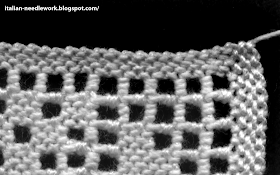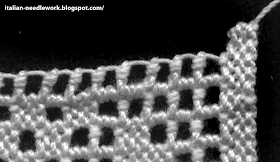Inspired by Renata's
punt'e nù snowflakes, I decided to try my hand at a
Puncetto Snowflake. Keeping in mind that I really shouldn't be trying to design patterns for Puncetto as I have nowhere near mastered the technique but you know, I was caught up in the holiday season.
I discovered that designs for Puncetto are not all that easy to make. You must keep it simple and small, otherwise you end up with a huge motif! My first design ended up having a base of 86 stitches... quite out of the question for a beginner like me to stitch, I don't even know how to do a selvedge of 86 stitches without running out of thread! Downsize and simplify. Ok. Design number two had a base of 48 stitches. Still too big for me but getting closer to a manageable size.
Since I had already done a 34 stitch base design from the
Puncetto Valsesiano book, I thought I could live with design number three.
I seem to have the hang of doing small squares and small holes without much trouble now, so this design uses those. A small square is made up of two stitches doing two forward rows.
I then tried to stitch this up using DMC Cordonnet Special #20. Can you believe that I tried three times and broke the thread in various inconvenient places? Very frustrating. I thought perhaps my thread was old and somehow compromised so I switched to a different ball but the same thing happened! This time thought it was even more frustrating as I had gotten almost to the half-way point. This must mean that I'm pulling too tight! I also have the horrible habit of splitting the thread with the needle which breaks it. Argh!
I cut off my thread to get it out of the way at the top of the column but can you see where the thread broke? How do you fix
that? Back to square one. This time I decided to take some photos along the way.
I couldn't find another ball of #20 so this time I'm using #40 with a #7 sharps needle. First the selvedge base of 34 stitches:
 |
| This is my selvedge or cimosa in Italian. |
Those little bumps are my stitches and I've triple-checked them so that I have 34.
Now I have to do the left edge which consists of a small square, two stitches doing two forward rows (click on the images for a closer look).
 |
| First forward row of two stitches. |
 |
| Return row of two stitches. |
 |
| Second forward row of two stitches. |
Next I have to do the small holes of the first row (in Puncetto you work bottom to top). These are small holes so I do a hooking on knot in every second stitch to get 15 holes.
First I need to hook on to my selvedge so this knot doesn't get counted as an actual stitch:
 |
| The hooking on knot which is call aggancio in Italian. |
Then I need to get back up to the top making the same size hole as my
square, so two return stitches on the loose thread which forms a kind of column (
colonnina in Italian):
Repeat for the remaining holes until the last one:
Here we need to build our right side small square, so once again the hooking on stitch doesn't count when we make our two stitches doing two forward rows:
On our return trip (after the first forward row) we need to catch and include the loose thread, so think of it as another hooking on stitch which doesn't enter into our calculations but needs to be there. I pull a little tighter for these ones to give my hole a better shape. Click on the photo for a closer look, I've highlighted the hooking on stitch that I'm talking about in red.
Now we're ready to go back to the beginning for our next row. We need to set ourselves up though by looking ahead at the pattern to see which holes will be empty and which will be filled in the row above, as we will do one less knot for the filled squares.
I had to change threads so you can see my ends which will be cut off later when they are more secure.
Well, so far so good, no breakage. I won't push my luck, that's it for today. If you want to stitch along, I'll be happy to answer questions but please remember that I'm stumbling along myself. If you are a reader who knows how to do this, and you see something I'm doing incorrectly, please leave a comment below!





























